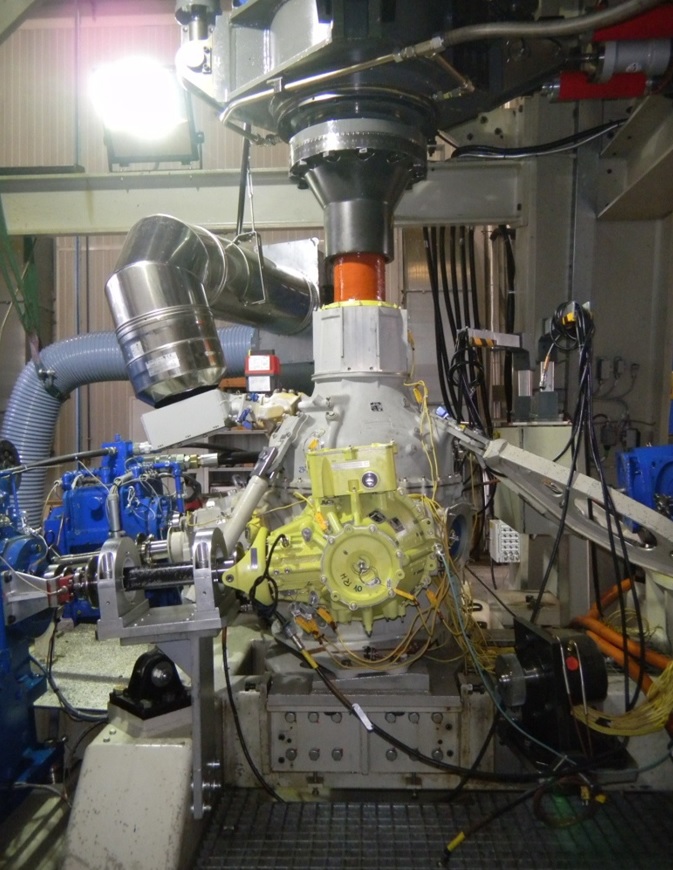Finmeccanica Strives For Greater Gearbox Loss of Lube Capability
Finmeccanica Helicopters (the recently rebranded AgustaWestland (UPDATE: and now Leonardo) is working to enhance the durability of helicopter Main Gear Boxes (MGBs) after a loss of lubrication.
The company’s Marco Tamborini presented their approach at the European Aviation Safety Agency (EASA) 9th Rotorcraft Symposium held in Cologne in December 2015. His presentation can be downloaded as part of a large zip file from the EASA website or here.
Background – Certification & Controversy
Often erroneously referred to as a ‘run-dry test’, an ‘Additional Test’, defined in 29.927(c), is required for Category A rotorcraft to demonstrate at least 30 minutes of operation after a loss of MGB lubrication (at least 29 minutes 35 seconds at the minimum torque necessary for sustained flight and then 25 second period to simulate the landing). In a certification memo issued in 2013, EASA say (emphasis added):
The intent of the rule change for Category A rotorcraft was to assure that these rotorcraft have significant continued flight capability after the loss of lubricant to any single transmission in order to optimize eventual landing opportunities. Extending the bench testing beyond 30 minutes, although not required, is considered highly desirable. Accomplishing this would further improve the capability of the rotorcraft to reach a suitable landing location in order to improve occupant safety when operating in remote geographic areas that include harsh environmental conditions.
The earlier certification of the Sikorsky S-92A MGB was controversial. As we have reported, the Norwegian Accident Investigation Board (AIBN) has recently commented:
In 2002, Sikorsky carried out a test of the main gear box, where the oil was drained… A catastrophic failure occurred after 11 minutes. Accordingly, the requirement for 30 minutes’ safe operation was not met. With reference to AC 29-2C, Sikorsky decided to install a bypass valve in the external oil cooler circuit. By closing the valve, any external oil leaks could be stopped. It was considered extremely remote that other leaks in the oil system could prevent a safe landing within 30 minutes. This was accepted by the certification authority, the Federal Aviation Administration (FAA).
Sikorsky was the only manufacturer to seek such an alleviation.
In service two leaks occurred outside of the S-92A oil cooler, destroying the myth that such failures were extremely remote. Tragically the second resulted in the S-92A fatal accident offshore Canada in 2009 in which 17 people died, although miraculously one passenger survived. This has triggered both further work on helicopter ditching and on transmission loss of lubrication rule making.
See also: Helicopter MGB oil system failure analysis using influence diagrams and random failure probabilities
The Finmeccanica MGB Loss of Lubrication Strategy
Finmeccanica has a 5 stage design strategy:
- Minimising the probability of a major oil loss (e.g replacing external pipe work with cast internal passages, having redundant pumps, fail-safe fittings, not sharing lubrication with external accessories and enhanced pre-delivery checks)
- Minimising power losses to reduce heat build up (e.g minimising the number of reduction stages, using fine pitch gears to reduce sliding velocity and super-finishing, adding shrouds to reduce windage drag, preferring roller bearings, ceramic elements and low friction coatings). At minimum cruise power the AW189 MGB efficiency is 96.5%.
- Maximising heat rejection (e.g improving MGB bay ventilation to help if flow through the oil cooler stops)
- Increasing high temperature running capability (e.g. maintaining clearances, plays and backlashes even at the highest expected temperatures, using High Hot Hardness (H3) steel for gears and bearings and heat tolerant silver-plated bearing cages)
- Maximising the value of residual oil (e.g oil retention, managing dripping rates etc).
Finmeccanica’s MGB Loss of Lubrication Results
The results of this design strategy are impressive. When tested at Cascina Costa in October 2012 the AW189 gearbox maintained a steady thermal balance during loss-of-lubrication test conditions for more than 50 minutes. The Flight Manual gives 50 minutes in the event of oil loss according to the company. A modified AW139 MGB achieved over 60 minutes during test in February 2015.
Tamborini also discussed the company’s modular approach to development testing (e.g testing input modules separately) as an affordable way to build test experience. He noted that since the mid 1980s, across all their product lines they have conducted 15 full MGB loss-of-lubrication tests and 24 module tests (7 and 18 respectively in the last 10 years).
Finmeccanica are also developing an ‘ultra-hydrid’ ceramic roller bearing concept.
Airbus (nee Eurocopter’s) approach is described in this 2003 paper: Loss of Oil Behavior of Eurocopter Gearboxes from AS350 to EC225
UPDATE 31 May 2017: NPA 2017-07 Rotorcraft gearbox loss of lubrication is issued for consultation (until 31 July 2017).
…this NPA proposes to amend CS 29.917(a) to include rotor drive system gearbox lubrication systems in the definition of the rotor drive system. This means that these lubrication systems will be considered to be within the scope of the design assessment of 29.917(b).
As the design assessment CS currently addresses the risk of single hazardous and catastrophic failures, additional material has been added to complement the Federal Aviation Administration (FAA) Advisory Circular (AC) 29-2C, supporting 29.917(b), specifically in the domain of lubrication systems. CS 29.927(c) on ‘loss of lubrication’ has been completely revised and replaced by a more objective-based CS that requires substantiation of the gearbox ability to continue safe operation (for at least 30 minutes) after a loss of lubrication to be followed by a safe landing. This is supported by substantial changes to the associated acceptable means of compliance (AMC).
Finally, CS 29.1521 has also been amended to include an additional power plant limitation that describes how the RFM emergency procedures should reflect the test evidence relating to a loss of lubrication.
UPDATE 27 July 2017: UK CAA comments on NPA 2017-07.
We have previously published another helicopter transmission related article on the same symposium: Helicopter HUMS Maintenance Credit: New Initiatives
AINonline has published a report by Thierry Dubois on the symposium: EASA Rotorcraft Symposium Spurs New Safety Ideas




Recent Comments